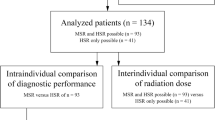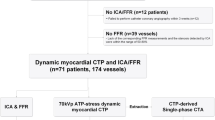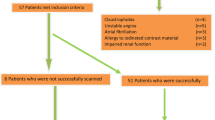Abstract
Objectives
To investigate the diagnostic performance of coronary CT angiography derived from dynamic CT myocardial perfusion imaging (CCTACT-MPI) by third-generation dual-source CT with reference to invasive coronary angiography (ICA).
Materials and methods
Patients with acute myocardial infarction and those who received successful reperfusion treatment were prospectively enrolled. Emergent ICA findings were used as the reference standard to assess the diagnostic performance of CCTACT-MPI for detection of significant coronary stenosis (diameter stenosis ≥ 50%). The radiation dose as well as image quality of CCTACT-MPI was also assessed.
Results
Twenty-six patients with 352 segments were ultimately included for analysis. The mean radiation dose of CCTACT-MPI generated from dynamic CT-MPI was 3.2 ± 1.1 mSv. Overall, 93.5% of total segments were interpretable (Likert score 2–4) whereas 6.5% segments were non-diagnostic (Likert score 1). Twenty-two patients with 84 segments were diagnosed by CCTACT-MPI as having ≥ 50% stenosis presence, whereas 268 segments had no obstructive stenosis. Compared to ICA findings, the overall diagnostic accuracy of CCTACT-MPI of patient-based and vessel-based as well segment-based analysis was 92.3%, 83.6%, and 85.8% respectively. As shown by ROC analysis, the AUC of CCTACT-MPI for detection of ≥ 50% stenosis was 0.833 on a per-patient level, 0.843 on a per-vessel level, and 0.822 on a per-segment level.
Conclusions
CCTACT-MPI derived from dynamic CT-MPI was able to accurately diagnose obstructive coronary stenosis with reference to ICA.
Key Points
• CCTA derived from dynamic CT-MPI had a diagnostic image quality in 93.5% of total segments.
• CCTA derived from dynamic CT-MPI was accurate in diagnosing obstructive CAD compared to ICA.
• The mean radiation dose of dynamic CT-MPI for reconstruction of CCTA was 3.2 mSv.




Similar content being viewed by others
Abbreviations
- CCTACT-MPI :
-
Coronary computed tomography angiography derived from CT myocardial perfusion imaging
- CNR:
-
Contrast-to-noise ratio
- CT:
-
Computed tomography
- DS:
-
Diameter stenosis
- ICA:
-
Invasive coronary angiography
- MPI:
-
Myocardial perfusion imaging
- NPV:
-
Negative predictive value
- PPV:
-
Positive predictive value
- SNR:
-
Signal-to-noise ratio
References
Rochitte CE, George RT, Chen MY et al (2014) Computed tomography angiography and perfusion to assess coronary artery stenosis causing perfusion defects by single photon emission computed tomography: the CORE320 study. Eur Heart J 35(17):1120–1130
Ko BS, Cameron JD, Meredith IT et al (2012) Computed tomography stress myocardial perfusion imaging in patients considered for revascularization: a comparison with fractional flow reserve. Eur Heart J 33(1):67–77
Ko BS, Cameron JD, Leung M et al (2012) Combined CT coronary angiography and stress myocardial perfusion imaging for hemodynamically significant stenoses in patients with suspected coronary artery disease: a comparison with fractional flow reserve. JACC Cardiovasc Imaging 5(11):1097–1111
George RT, Arbab-Zadeh A, Miller JM et al (2012) Computed tomography myocardial perfusion imaging with 320-row detector computed tomography accurately detects myocardial ischemia in patients with obstructive coronary artery disease. Circ Cardiovasc Imaging 5(3):333–340
Bamberg F, Becker A, Schwarz F et al (2011) Detection of hemodynamically significant coronary artery stenosis: incremental diagnostic value of dynamic CT-based myocardial perfusion imaging. Radiology 260(3):689–698
Schwarz F, Hinkel R, Baloch E et al (2013) Myocardial CT perfusion imaging in a large animal model: comparison of dynamic versus single-phase acquisitions. JACC Cardiovasc Imaging 6(12):1229–1238
Bamberg F, Marcus RP, Becker A et al (2014) Dynamic myocardial CT perfusion imaging for evaluation of myocardial ischemia as determined by MR imaging. JACC Cardiovasc Imaging 7(3):267–277
Rossi A, Merkus D, Klotz E, Mollet N, de Feyter PJ, Krestin GP (2014) Stress myocardial perfusion: imaging with multidetector CT. Radiology 270(1):25–46
Danad I, Szymonifka J, Schulman-Marcus J, Min JK (2016) Static and dynamic assessment of myocardial perfusion by computed tomography. Eur Heart J Cardiovasc Imaging 17(8):836–844
Pelgrim GJ, Duguay TM, Stijnen JM et al (2017) Analysis of myocardial perfusion parameters in an ex-vivo porcine heart model using third generation dual-source CT. J Cardiovasc Comput Tomogr 11(2):141–147
Li Y, Yu M, Li W, Lu Z, Wei M, Zhang J (2018) Third generation dual-source CT enables accurate diagnosis of coronary restenosis in all size stents with low radiation dose and preserved image quality. Eur Radiol 28(6):2647–2654
Leipsic J, Abbara S, Achenbach S et al (2018) SCCT guidelines for the interpretation and reporting of coronary CT angiography: a report of the Society of Cardiovascular Computed Tomography Guidelines Committee. J Cardiovasc Comput Tomogr 8(5):342–358
Stehli J, Fuchs TA, Bull S et al (2014) Accuracy of coronary CT angiography using a submillisievert fraction of radiation exposure: comparison with invasive coronary angiography. J Am Coll Cardiol 64(8):772–780
Hanley JA, McNeil BJ (1982) The meaning and use of the area under a receiver operating characteristic (ROC) curve. Radiology 143(1):29–36
Layritz C, Schmid J, Achenbach S et al (2014) Accuracy of prospectively ECG-triggered very low-dose coronary dual-source CT angiography using iterative reconstruction for the detection of coronary artery stenosis: comparison with invasive catheterization. Eur Heart J Cardiovasc Imaging 15(11):1238–1245
Yin WH, Lu B, Hou ZH et al (2013) Detection of coronary artery stenosis with sub-milliSievert radiation dose by prospectively ECG-triggered high-pitch spiral CT angiography and iterative reconstruction. Eur Radiol 23(11):2927–2933
Meinel FG, Canstein C, Schoepf UJ et al (2014) Image quality and radiation dose of low tube voltage 3rd generation dual-source coronary CT angiography in obese patients: a phantom study. Eur Radiol 24(7):1643–1650
Matveeva A, Schmitt RR, Edtinger K et al (2018) Coronary CT angiography in patients with atrial fibrillation: standard-dose and low-dose imaging with a high-resolution whole-heart CT scanner. Eur Radiol 28(8):3432–3440
Andreini D, Pontone G, Mushtaq S et al (2018) Image quality and radiation dose of coronary CT angiography performed with whole-heart coverage CT scanner with intra-cycle motion correction algorithm in patients with atrial fibrillation. Eur Radiol 28(4):1383–1392
Albrecht MH, Nance JW, Schoepf UJ et al (2018) Diagnostic accuracy of low and high tube voltage coronary CT angiography using an X-ray tube potential-tailored contrast medium injection protocol. Eur Radiol 28(5):2134–2142
Funding
This study has received funding from the National Natural Science Foundation of China (Grant No.: 81671678), Shanghai Municipal Education Commission-Gaofeng Clinical Medicine Grant Support (Grant No.: 20161428), Shanghai Key Discipline of Medical Imaging (No.: 2017ZZ02005), and The National Key Research and Development Program of China (Grant No.: 2016YFC1300400, 2016YFC1300402).
Author information
Authors and Affiliations
Corresponding author
Ethics declarations
Guarantor
The scientific guarantor of this publication is Dr. Jiayin Zhang.
Conflict of interest
The authors of this manuscript declare no relationships with any companies, whose products or services may be related to the subject matter of the article.
Statistics and biometry
No complex statistical methods were necessary for this paper.
Informed consent
Written informed consent was acquired in all patients.
Ethical approval
Institutional Review Board approval was obtained.
Methodology
• Prospective
• Comparative study
• Performed at one institution
Rights and permissions
About this article
Cite this article
Dai, X., Yu, M., Pan, J. et al. Image quality and diagnostic accuracy of coronary CT angiography derived from low-dose dynamic CT myocardial perfusion: a feasibility study with comparison to invasive coronary angiography. Eur Radiol 29, 4349–4356 (2019). https://doi.org/10.1007/s00330-018-5777-4
Received:
Revised:
Accepted:
Published:
Issue Date:
DOI: https://doi.org/10.1007/s00330-018-5777-4




